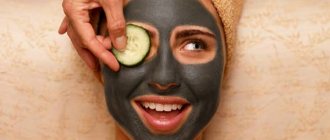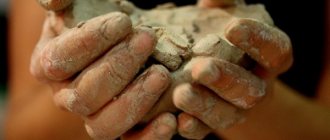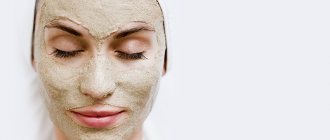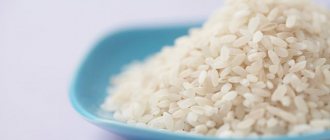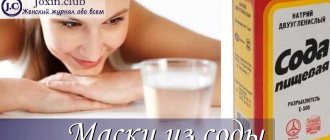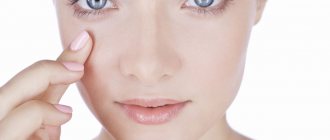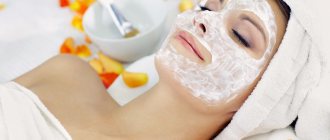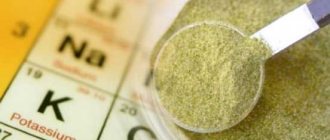Clay masks are one of the most popular and sought after skin treatments in home cosmetology. They are used by people of different ages, and even genders. It would seem that clay, in essence, is dirt, but we require cleansing of the skin. How, then, can these two factors be compared?
The fact is that clay is a specific mineralized rock that perfectly absorbs and retains moisture, unlike other rocks. With its help, you can not only deeply cleanse the skin and give it powerful detoxification, but also nourish it, moisturize, and smooth it. A mask based on it is loved by the fair sex all over the world, and their ages range from young to old. But, alas, like all good things, such a remedy requires dosed use.
Preparing the mask is an important step
Every woman knows how to make masks, but clay masks have their own characteristics, and if you don’t delve into them, you can harm your facial skin . No matter what color of clay you choose, you need to prepare it correctly!
As a rule, we take twice as much liquid, be it water, milk, mineral water or herbal infusion. But we always focus on what other ingredients will be present. If it is semolina or oatmeal, then more water is needed, as they will swell a little. And if the mask contains cucumber juice or a lot of butter or sour cream, then it is better to put less liquid. We always take into account not the recipe, but observations while preparing the mask. The consistency should be such that it is convenient to apply the mask.
We prepare a clay mask in any container except metal . Clay reacts poorly to metal. Ceramics and glass are more suitable options. Stir the ingredients with a wooden spoon. If you don’t have it, then at least take an ice cream stick. You can also buy a glass rod; it is sold in stores for soap making and handmade cosmetics.
We prepare the mask when the skin is cleansed, all the ingredients are purchased, collected in one place, unpacked and weighed. Initially, this list may seem funny. However, when you start preparing a mask, everything seems easy, but then one component is missing, another was lying on the shelf, and now it’s not clear where.
While you are looking, the clay dries out and the mask is ruined. Therefore, everything must be thought out in advance.
The finished mask can be stored in the refrigerator if there is sufficient quantity left and it contains a lot of essential oils. Oils act as a kind of preservative. But we leave the finished mask for no more than 3 days. That is, if the procedures need to be done 2 times a week, then the mask can be prepared for two times. If the mask consists only of clay, it is better not to leave it, it will dry out and will not be useful.
Manifold
The usefulness of clay lies in its composition, rich in minerals. Different types of this natural material contain aluminum, silicon, manganese and other substances. Aluminum and manganese have a drying effect, and silicon stimulates collagen synthesis in the dermis, renewing and tightening it.
You need to start making clay masks from the age of 25-30. They will saturate the skin with nutrients, which will help replenish vitamin deficiencies and prevent loss of elasticity and the appearance of wrinkles. Clay has whitening properties that allow it to be used in the fight against pigmentation.
Different clays have different effects on the skin. You need to choose it based on your skin type and the imperfections you want to eliminate.
- White clay - suitable for those with oily skin prone to imperfections. It has an anti-inflammatory effect, disinfects, removes oily shine, and tightens pores.
- Blue clay is considered the most useful of all types. It has a whitening effect, so it is used against pigmentation. Smoothes facial wrinkles, evens out the skin, treats acne, and promotes the healing of small wounds.
- Green clay - got this color thanks to the iron oxide in its composition. Suitable for those with dry and sensitive skin, it moisturizes and helps restore moisture balance. Makes the skin elastic and gives a rejuvenating effect.
- Red clay - got its color due to the high content of copper and zinc. Suitable for skin prone to allergies and irritations. Soothes, softens and moisturizes, exfoliates and tightens.
- Pink clay is an artificially created type of clay. It is obtained by mixing the types of white and red. Used to moisturize and nourish all skin types.
- Yellow clay is rich in potassium and iron. Suitable for tired and aging skin. Gives freshness to the face and improves its color. Recommended for early aging of oily and normal skin.
- Black clay - thanks to the rich mineral composition of black clay, the effect of the mask is similar to a scrub: deep cleansing of pores, removal of dead cells, getting rid of blackheads. Black clay has an antitoxic effect - it removes harmful substances from the skin.
- Gray clay - This type of clay is mined from the seabed. Recommended for moisturizing and nourishing dry skin. Tones and rejuvenates.
Preparing the skin before the procedure
Preparing the skin is a very important stage; if it is neglected, the procedure will not be as effective.
You can go to the salon for a gentle hardware cleaning or do a scrub at home. We use a store-bought scrub or prepare it ourselves using coffee, oatmeal and other ingredients. This exfoliating procedure is necessary in the case of a moisturizing or tightening mask. If you are making a cleansing mask or with components that themselves work as a scrub, then preliminary scrubbing is not necessary.
On the day of the mask, scrubbing the skin is prohibited , as it can be damaged.
After mechanical cleansing of the face or deep cosmetic peelings, we resort to clay masks only after 2 weeks.
Immediately before preparing the mask, wash your face. Depending on your skin type, we use milk, gel or foam to cleanse your face. Next, steam your face. You can take a shower or stand over a steaming infusion of medicinal herbs. Pat the skin dry with a soft towel or kitchen napkins. Now the skin is clean and ready to receive all the benefits from the mask. Cosmetologist about preparing the skin before the mask:
Recommendations for preparation and use
To ensure the procedure is carried out correctly, follow these tips:
prepare the mixture in a glass bowl, stir the mixture with a wooden spatula; using metal utensils risks a chemical reaction, as a result of which the clay mixture acquires unexpected properties and can irritate the skin.- When diluting clay powder, use cool water and stir the mixture constantly.
The ideal consistency of the mass should resemble thick sour cream. If you dilute the clay too much, the mass will drain from the face, and if it is thick, it will lead to tightness of the skin. - The method for preparing the clay mixture is usually indicated on the packaging of the clay powder. Most often, the amount for preparing a mask is two tablespoons. Water – approximately 80 ml.
Important points about using and applying masks
Before applying the mask, you need to figure out what materials are suitable for working with clay. The clay does not lose its healing properties when in contact with a wooden spatula, designed specifically for easy and convenient application. Of course, not every home has one. Therefore, you can use a brush for masks with natural or artificial bristles . As a last resort, apply the mask with a cotton pad. If you have combination skin, then apply a thicker layer to the problem T-zone; the clay will draw out excess fat.
Dry skin on the cheeks will give up all the moisture with a thick layer, so apply a thin layer to this area.
To determine how long you need to keep the mask on, it is important to understand that the time of the procedure with clay directly depends on your skin type and the type of mask .
- For dry, thin skin, keep moisturizing masks for up to half an hour.
- And if the mask is for acne, blemishes, tightening or whitening, then keep it on for up to 15 minutes. We start with 5 minutes.
- Leave masks for oily and combination skin on for 30 minutes.
While the mask is on your face, it is better to lie down with it and relax, since clay masks are not the lightest . They weigh down the skin of the face and can stretch it when positioned vertically.
Clay masks for dry or aging skin
Dry and aging skin needs gentle treatment, so the following clay masks are suitable for it:
with jojoba oil.
Add half a teaspoon of oil to the prepared mixture of clay and water and apply for 10 minutes.The mask will moisturize the dermis and help defeat fine wrinkles.
- With olive oil and yolk.
Mix white clay (2 tablespoons) with oil until it becomes a paste, add the yolk and mix thoroughly.
Place the mixture on your face for 5-10 minutes.The use of this product will ensure elasticity and hydration of the skin.
- With sour cream.
Mix white or pink clay with rich sour cream and leave for 10 minutes.With regular use of the mask, shallow wrinkles will disappear.
With rice flour.
Mix flour with blue clay (one tablespoon at a time) and pour water into the dry mixture, stirring with a wooden spatula until the consistency of the mixture resembles sour cream.Apply for 10 minutes.
The product will refresh and soften the dermis.
TIP: After removing the mask, apply a nourishing face cream to your skin.
Wash off the mask correctly
There are two main ways to remove a mask from your face. You can just wash your face. The water should be warm. You can also remove the mask with a cotton pad soaked in water.
We wipe dry skin with tonic or herbal infusion, for example, chamomile. Apply nourishing cream. It is not necessary to apply the cream to other skin types.
Listen to the sensations, whether there is a tightness effect after the mask.
- After washing off the mask, dry skin should be toned with a decoction of medicinal herbs or a store-bought tonic.
- We also wipe combination skin with a cotton pad soaked in tonic.
Whatever the mask, be sure to moisturize thin, dry skin with cream. We apply cream to combination and oily skin only after the mask, which dries it out. If it contained a lot of essential oils and fatty components, then the cream is already superfluous.
Contraindications
Clay is a natural, environmentally friendly material; when using it, you will not experience allergic reactions. However, if you bought a ready-made clay mask or are experimenting with different ingredients at home, study the composition. Does it contain components that will cause you to be individually intolerant?
You should not make a mask if you have inflammation, irritation or purulent pimples on your face. Do not apply the mixture to the skin around the eyes. Due to the lack of sebaceous glands, the skin in this area is dry and sensitive, and clay dries well.
For dry skin, cosmetologists recommend leaving the area of the nasolabial folds untouched to avoid drying out and deepening wrinkles.
Clay has a moisturizing effect only until it dries. When it dries, on the contrary, it begins to dry out and tighten the pores. Therefore, for dry skin, it is recommended to either purchase emulsion-based clay masks, or add a few drops of oil to a mask you prepare yourself.
It's about the color
First, let’s decide which color is right for you, because there is a wide variety of them in nature. And we love variety, don’t we? 
The choice should be taken responsibly, but it is not at all difficult, the main thing is to identify the problem.
- White (or kaolin)
Should attract your attention if you have oily, very sensitive or problematic skin. Being an excellent antiseptic, it removes excess fat, tightens pores, and also has whitening properties.
- Blue
This mask can safely be called healing! It helps get rid of acne, fights expression lines, helps make skin pigmentation less expressive, and evens out complexion.
- Black
It contains many microelements. It has the ability to deeply cleanse, helps remove toxins, and makes the pores on the face much smaller. Helps prevent acne. Moisturizes.
- Green
It is used for those whose sebaceous glands secrete excess fat. It perfectly helps to narrow pores, dries well and degreases the surface of the face.
- Gray
Great for dry skin. It does an excellent job of moisturizing, nourishing, and also does a kind of peeling.
- Pink
It is a product of combining red clay with white clay. Will be effective for use with any skin. Its universal composition will help nourish, cleanse the face, and smooth out existing wrinkles.
- Red
If you are prone to various types of rashes, it will be perfect for you. With its help you can relieve inflammation and tighten the contour of your face.
- Yellow
Most suitable for use on oily or combination skin, during any inflammatory processes. It will help in removing toxins and saturate with oxygen, which will result in an improvement in complexion.
Hair styling clay
It is impossible to prepare a hair styling product from clay at home, but there is a wide variety of ready-made products from different companies, such as estel, wella, taft, londa and many others. In addition, there are special lines of men's clay for hair styling, so that the strong half of humanity is not left deprived. Most often, modeling clay for hair is made on the basis of blue rock. With this hair care product you can create volume without sticking. After styling your hair with clay, your hair does not feel dirty or greasy.
Despite its strong hold, the clay is easily washed off with shampoo.
pros
— Easily washed off with shampoo
— Guarantees lasting fixation
- Hair becomes elastic
– Increases hair volume
— Allows you to design a hairstyle from a plastic base
- It is used economically.
Minuses
— Not suitable for styling densely textured curls
— You need skills in applying the composition to your hair.
Tags: hair hair loss
Market Analytics
- Black Lives Matter movement: reaction and consequences for the beauty industry
- COVID-19 is changing the rules of the game in the cosmetics market
- Beauty of the future: cosmetic innovations 2021
Convenient search for beauty salons on our website
Beauty salons in Moscow Beauty salons in St. Petersburg Beauty salons in Ekaterinburg Beauty salons in Novosibirsk
Latest blog posts on our website
- Naturecream / Tremella Extract - Snow Mushroom Detox for Skin
- Prostye-sovety / How to visually enlarge your lips with makeup
- Naturecream / Apricot kernel oil for face
- Naturecream / MATRIXYL3000 - the best skin elasticity stimulator
- Naturecream / SPF in Natural Oils
- Naturecream / Geranium (Pelargonium) oil for skin health and beauty
- Prostye-sovety / Save on a beauty salon: procedures that can be done at home
- Naturecream / Growth Factor - brings back youth?
- Oksana-Lezina / 3 effective abdominal exercises from a fitness instructor for beginners
- Prostye-sovety / Making perfect curls at home
Latest forum topics on our website
- Natalya / How to properly make a gelatin mask?
- Mrs._Smith / Badly sunburned! What to do?((
- Ice / Is it necessary to combine fitness classes with a diet?
- Antonova / What can be used for hair loss?
- Radio operatorKat / Who was on a protein diet?
Reviews about the Hair Clay
- Elena | 2016-12-24 17:00:12 Clay helps me very well against oily shine, I make a mask with blue or white clay once a week, wash my hair after 3 days, my hair doesn’t get greasy, and earlier the next day it’s already icicles. Cheap and effective, no need to buy expensive products.
[Leave a review]
Leave your review of this procedure (it will appear on this page after moderation)
In this form, describe only
your personal
experience of undergoing the procedure.
In order to leave a comment regarding the content of the article, use another form - in the “comments” block at the bottom of the page.
Other articles in this section
| Masks for blond hair Blonde hair of any shade allows ladies to look much more feminine, appear more fragile and graceful. It is not surprising that many men prefer blondes - they have something of a small, naive girl who they want to protect from the harsh everyday life. At the same time, blonde hair requires special care, since it is not particularly thick and dense. |
| Castor oil for hair Currently, thanks to the development of the cosmetology industry, the choice of hair products that have a tonic, strengthening, nourishing and restorative effect is very diverse. However, the most popular are still products containing natural ingredients of organic origin. |
| Cyanocobalamin (vitamin B12) for hair Vitamin B12 belongs to the group of cobalt-containing biologically active substances (cobalamins), is a water-soluble vitamin that can accumulate in the body in the liver, kidneys, lungs and spleen. Many women use vitamin B12 to restore hair structure and thickness, and it also has a positive effect in accelerating hair growth and improving pigmentation. |
| Hair masks with oils Vegetable oils began to be used for cosmetic purposes back in Ancient Greece. And after many millennia, their use has only increased. Today, women are more and more inclined to use natural products, which explains the relevance of vegetable oils in cosmetology. This article will discuss the use of oils in hair masks for therapeutic and preventive purposes. |
| Lightening hair at home Throughout the centuries, men have paid attention to women who have well-groomed and healthy hair. Representatives of the stronger sex have always been proud of the fact that next to them are the owners of beautiful curls or lush curls. Ideally, it was hair of natural color, but some privileged people had the opportunity to dye their hair, thus demonstrating their position in society. |
| Onion hair mask Today it is common to use the services of professional hairdressers and stylists, but not a single stylist will help you look your best if your hair is brittle, dull and weak. Hair care should become an integral part of your life. This can be done not only using cosmetics from pharmacies and stores, but also with the help of folk recipes. One of the reliable ways to strengthen hair is a mask made from onions. |
| Oak bark for hair Store-bought hair products are not always effective. In this case, you can use an alternative - folk remedies using natural ingredients. This article will focus on oak bark. |
| Argan oil for hair North Africa is the grandeur and embodiment of desert romance, beauty and mystery. The sands of its evergreen oases hide treasures, among which stand out trees that can live under the scorching rays of the sun - Argania spinosa, with crowns of thorny branches and twisted trunks. |
| Nettle for hair It has been scientifically proven that many cosmetic problems develop due to nervous tension, against the background of constant stress. The skin becomes dull, wrinkles appear, hair becomes brittle and constantly falls out. But not everything is so sad; you can restore the beauty and health of your hair with the help of herbal medicine. |
| Jojoba oil for hair A mysterious and unusual plant called Simmondsia or Jojoba (Simmondsia chinensi) can be considered its homeland in the uninhabited areas of Northwestern Mexico and the United States. Its fruits are no less unusual. They have an intricate triangular shape and from their seeds people extract jojoba oil, which has such unique and valuable properties that women have used this product for their hair and skin for many centuries. |
Comments
- Editorial | 2016-10-04 22:05:01 Maria, for 1.2 hours the mask is applied to the scalp, not to the hair. This mask is used for crusty scalp to reduce itching. In this case, there should be no damage to the skin (abrasions, scratches, etc.).
- Maria |
2016-10-02 18:57:07 At the beginning you wrote that the clay needs to be kept on the hair for 20.30 minutes. then it will be difficult to wash it off. But in the recipe with salt you suggest keeping the mask on your hair for 1.2 hours. How to understand? Thank you.
What's the result?
Don’t laugh too much at the photo)) Although no... laugh, I’m glad if my wonderful appearance cheers you up))
So, are you tired of using unreasonably expensive branded lotions and creams that promise super moisturizing, super cleansing and anti-wrinkle treatment, but, to put it mildly, do it poorly?
It's time to do something that will really help. Nature has everything you need to make you look great!
Take advantage of this.
